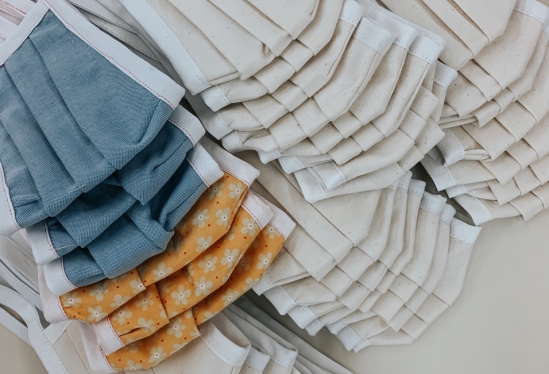Santa Barbara’s COVID Mask Makers Get Organized
County Gets a Sewing Czar as Community Keeps on Giving

Hundreds of people are now busily sewing masks for neighbors, first responders, medical workers, and anyone and everyone — dedicated to doing their part to make the COVID infection curve as flat as a pancake. So many are involved, yet many more seek a way to help. To get the activity organized, Santa Barbara County has brought in Judi Weisbart to be the queen for the county’s busy bees.
“Each group is different,” Weisbart said of the mask sewing. “Forty are in Carpinteria and about the same in the Quilters Guild. The Bucket Brigade has about 170, and churches and other neighborhood groups are all making face coverings.” In her work as a consultant, Weisbart has managed the rollout of many efforts to connect donors with works in need of their goodness, and she continues her energetic and thoughtful approach with mask-making.

Even as the week went by between the idea and the inception, Weisbart made connections with the national organization Masks Now to set up a Facebook page for Santa Barbarans —@SBCMaskNetwork — found wholesalers, received materials, arranged for distribution, and much more. “This is a huge undertaking on more levels than I thought when I took this on,” she confessed. “Masks are coming from individuals who make five a day to professionals who make hundreds.” Importantly, she got the Santa Barbara Foundation involved as a nonprofit to receive cash donations to the cause.
While Weisbart handles linking county departments to the mask makers, Summerland activist Lee Heller is coordinating the supply chain. To make a mask, give supplies, or get supplies, email Heller at sbcmasknetwork@gmail.com. The priority is to get masks to frontline and essential workers, said Heller, but the group hoped to get them to everyone who needed one.
Already, the mask makers have leapt into action on their own. The Coastal Quilters Guild of Santa Barbara and Goleta saw Foodbank distributing meals at the United Boys & Girls Clubs, serving more than 34,000 kids and families as of last week. The more than 100 volunteers needed masks, said club CEO Michael Baker, and the Quilters Guild stepped up. “Nationally and globally, home sewists have become the Rosie the Riveters of the day, answering a real and immediate need,” said Guild president Karen Pickford, whose group has distributed 700 masks so far.
More Giving
Amy Beth Katz is giving a thought to a different demographic. She worries the virus will spread among the homeless people living on the streets. “I understand why so many have given up even trying to social distance — although I do not condone it. What else can they tell themselves when the city hasn’t even been providing the most basic sanitary requirements like an adequate amount of bathrooms or handwashing stations? Or distributing protective gear, or what they most need: roofs over their heads and separated living quarters? They will get it, some will die, and it is being spread around the downtown community.” Laundry has become an issue for some as well, and the sewn masks need to be washed between uses, Katz pointed out.
On a recent Wednesday, “We distributed over 20 bags of clothing and served a catered meal to 70 people living on the streets and in their cars,” Katz said of her group of volunteers at B’nai B’rith. “I handed at least one pair of gloves to every person, in many cases, I gave two or three sets. I only handed out a few masks, and so wish we had more, even bandanas.”
About two weeks after they set up their 3-D printers, UC Santa Barbara researchers delivered to Cottage Hospital the 188 face shields they and a group of local tech companies had made. Face shields go over the goggles and facemasks when medical staff do a procedure, like intubating a patient on a ventilator, that will produce aerosolized viruses. The PAPR mask, which stands for powered and supplied air respirator, puts a fan in the helmet to pull air through a HEPA filter, thus removing 99 percent of germs. As many as 800 of the masks, which are made through a collaboration between UCSB and area tech companies, are expected to be finished this week.

The lull on campus, aside from professors scrambling to translate their lectures to an online format, has enabled the costume makers at the Theater and Dance department to put their skills to making masks. Denise Umland and Lillian Hannahs are working from home and have so far made 200 masks for the Visiting Nurses and Cottage. “It is time-consuming, monotonous, and deeply rewarding,” said Hannahs, who is normally a cutter and draper. Devin Gee in scenery and props has been using his 3-D printer to make tension release bonds for the masks. The results have been admired for their professional quality.
The Goleta Chamber of Commerce has been collaborating with other chambers on business-related webinars for the challenges of SBA loans, and it teamed up with area businesses to form Masks4Biz. Last week, they distributed 20,000 masks to companies like Anna’s Bakery. “We’ve been working toward reopening with limited service, and one of our challenges was where to get masks,” said Lisa Boelter, co-owner of Anna’s Bakery. “We were so relieved when the Goleta Chamber emailed us the offer to help. Now we can resume our place in the heart of the community, at least in a small way.”
At the Santa Barbara Independent, our staff continues to cover every aspect of the COVID-19 pandemic. Support the important work we do by making a



You must be logged in to post a comment.